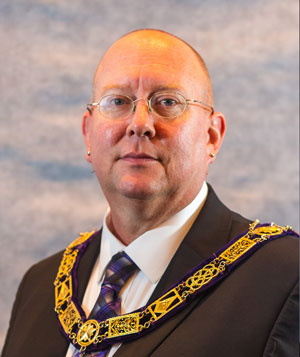A Short History of Grand Honors
Masonry in New Mexico 101.
By: Tyler Anderson
Grand Historian

In the first edition of the New Mexico Monitor and Ceremonies, there were three styles of Grand Honors prescribed, these being Private, Public, and Funeral. (Monitor, 1932, p.113)
The Private Grand Honors were not discussed in detail, being considered a tyled piece of ritual, given (and seen) only by Master Masons, and in very particular circumstances. Only at the installation of a Grand Master, or the visit of the Grand Master or other Grand Officers to the Subordinate Lodge could the “‘Battery’ or ‘Three times three’ [be] performed.” In this era, only Master Masons could be present at such events. Much of the verbiage used in our Monitor at the time was actually a paraphrase from Mackey’s Encyclopedia, from the entry on “Honors, Grand.” It can be deduced that this was similar to what we use today as Grand Honors generally. However, there was also footwork involved—but since there is no description, we don’t know what that footwork was: it may have been the three steps.
Public Grand Honors were described in detail, and were incidentally also a three times three battery salute. Once again, the text in our Monitor paraphrased Mackey. These Honors were given by a choreography of the palms first striking the shoulders in a gesture mirroring the position of prayer, then together over the head, then falling and striking the thighs. This was repeated three times.
Funeral Grand Honors were also described, and involved no loud noise making, but rather three gestures, accompanied by words. The hands would be raised over the head, palms inward (an attention-grabbing gesture) while saying, “His spirit to God;” then the arms folded in prayer while saying “His memory in our hearts;” and finally both hands extended toward the grave, palms upward, accompanied by, “His body to the earth.”
The origins of any or all of these is probably not determinable. There are mentions of such salutes going back at least to the first edition of William Preston’s Illustrations of Masonry from 1772, where he mentions them in connection with the consecration of halls and at funerals. The 1805 first American edition of Laurence Dermot’s Ahiman Rezon mentions Grand Honors in context of consecration of a hall, the constitution of a Lodge, and at the installation of officers. Neither Thomas Smith Webb nor Jeremy Ladd Cross, from whose works our ritual fundamentally descends, seem to mention the salutes in their contemporary editions. (Preston, 1772, pp.220, 241; Dermot, 1805, pp.53, 54, and 56)
The division of Grand Honors into Public, Private, and Funeral forms possibly began in the United States in the early 1800s. The term “public grand honors” showed up in 1820 in the Proceedings of the Grand Lodge of Connecticut. In Rhode Island their 1864 annual Proceedings included a proposition by the Grand Master “recommending the adoption of certain private Grand Honors, and Funeral Grand Honors and they are adopted, as exemplified by him.” (GLCN Proceedings, 1820, p.307; GLRI Proceedings, 1864, p.24)
In the New Mexico Monitor, all three styles of Grand Honors were mentioned in each edition until the 1951 (fifth) edition, when the Funeral Grand Honors disappeared following the recommendation of the ritual committee at the Annual Communication of that year. Also at the 1951 Communication, Grand Master Charles Stevens discussed that the footwork of the Private Grand Honors was unnecessarily complicated, and he found that having the men attempting to perform both the (manual) battery and the (pedal) footwork simultaneously was making a mess of the whole thing. He further noted that in other Grand Jurisdictions they have no footwork. This suggests that said footwork may have been something that was, at least by 1951, if perhaps not in the past, unique to New Mexico. Both the wholesale removal of the Funeral Grand Honors, and the discontinuation of footwork from the Private Grand Honors were approved by the body. (GLNM Proceedings, 1951, pp.51, 106)
Then in the 1972 ninth edition of the Monitor, the Public Grand Honors also disappeared. At this point the formerly-tyled Private Grand Honors were reworded to be used at all events, “in the presence of the profane as well as the initiated.” Our Proceedings luckily include a narrative. At the 1971 Annual Communication, Grand Master B. Mell Grissom’s Recommendation #7 was that the then-Private Grand Honors become the Public Grand Honors. He further recommended that new Private Grand Honors become the performance of the due guards and penal signs of the three degrees. Conversely, the ritual committee report that year recommended that no changes be made. Facing an apparent stalemate on the issue, WB Norm Ribble (then Master of Temple Lodge) moved that the three times three be simply used as Grand Honors for any and all occasions, and that motion was passed by the assembly. (GLNM Proceedings, 1971, pp.27, 98)
